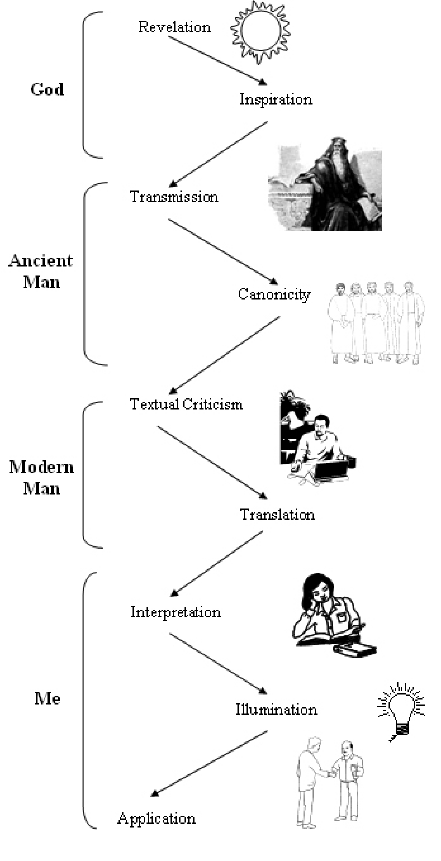1. Introduction to How We Got the Bible
Introduction
“How The Bible Came From God To Us”
|
|
Revelation - God communicating to man what He wants us to know (Hebrews 1:1) |
|
Inspiration - God superintending human writers to compose and record His revelation to mankind (2 Timothy 3:16; 2 Peter 1:21) | |
|
Transmission - The ancient process of accurately copying Hebrew and Greek scriptures for successive generations | |
|
Canonicity - God guiding the early church to recognize what books are inspired | |
|
Textual Criticism -The modern process of comparing existing Hebrew and Greek manuscripts to determine what is original | |
|
Translation - The process of translating the Bible from the original Hebrew and Greek into a modern language | |
|
Interpretation - The process of a reader studying to understand what God’s Word means (2 Timothy 2:15) | |
|
Illumination - The process of the Holy Spirit helping the reader understand and apply the Bible (John 16:13) | |
|
Application - The process of putting into practice what the reader has learned (James 1:22) |
The Bible’s Reliability from Revelation by God to Application by Reader
|
|
Definition |
Degree of Certainty |
Factors Determining Certainty | |
|
|
Revelation |
God communicating to man what He wants us to know (Hebrews 1:1) |
Revelation is settled and sure because there is only one Source of revelation. |
Revelation rests upon the trustworthy character of God. |
|
Inspiration |
God superintending human writers to compose and record His revelation to mankind (2 Timothy 3:16; 2 Peter 1:21) |
Inspiration is settled and sure because there is only one process of inspiration, even though there were many writers. |
Inspiration rests on God’s total control of the human-divine process. | |
|
Transmission |
The ancient process of accurately copying Hebrew and Greek scriptures for successive generations |
The transmission of the Bible texts was amazingly accurate, but it was many scribes copying |
Transmission depended upon scribes using a careful process that God protected. | |
|
Canonicity |
God guiding the early church to recognize what books are inspired |
Canonicity is settled and sure. There is only one final collection of inspired books. |
Canonicity depended upon God controlling an otherwise human process of church councils. | |
|
|
Textual Criticism |
The modern process of comparing existing Hebrew and Greek manuscripts to determine what is original |
-Very reliable overall Several different theories exist about which original manuscripts are the most reliable. |
The accuracy of existing texts depends on the competence of the scholars involved in textual criticism and upon the texts available. |
|
Translation |
The process of translating the Bible from the original Hebrew and Greek into a modern language |
We have many reliable translations in English and other languages. |
Translations depend on the knowledge and accuracy of the translator(s) and, to some degree, upon their interpretive understanding | |
|
Interpretation |
The process of a reader studying to understand what God’s Word means (2 Timothy 2:15) |
The reliability of interpretation varies greatly. Many interpretations are suggested |
Interpretation depends upon the accuracy, the theology and sometimes the honesty of the Bible student, teacher or writer. | |
|
Illumination |
The process of the Holy Spirit helping the reader understand and apply the Bible (John 16:13) |
The Holy Spirit’s illumination is available to all believers, but accuracy will vary greatly |
Illumination depends upon the Bible reader’s accuracy, honesty and even spiritual maturity. | |
|
Application |
The process of putting into practice what the reader has learned (James 1:22) |
Applications will vary greatly. Many applications are legitimately possible. |
Specific application depends upon the person’s needs and their willingness to obey God. |
Related Topics: Bibliology (The Written Word)




